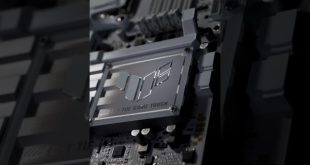The Gigabyte Z87-D3HP motherboard conforms to a ‘compressed' ATX form factor which sees it measuring 30.5 x 22.4cm. Don't worry about case compatibility; the Gigabyte Z87-D3HP will fit in a case that is capable of housing a standard ATX motherboard. The only difference is that the right column of stand-off points is omitted.
Despite its entry-level price point, Gigabyte's Z87-D3HP maintains the attractive matte black PCB colour that is found on the company's higher-priced motherboards.
Four DIMM slots can hold up to 32GB of DDR3 memory at speeds of up to 3000MHz. We will test Gigabyte's memory frequency support claims with a 2933MHz set of G.Skill TridentX memory.
The 24-pin power connector is found in its usual location along the board's upper-right edge. Due to the sub-ATX width of the Z87-D3HP, plugging in the 24-pin power connector does result in a fair amount of bending to the motherboard's PCB.
Two outwards-facing USB 3.0 headers are found in the typical location that makes them easy to access for front panel cables. One header is provided by a Renesas uPD720210 USB 3.0 hub, while the other uses the Z87 chipset's ports.
Moderated by an International Rectifier CHiL 3564 digital PWM controller, four power phases are used to feed an LGA 1150 CPU through a socket that features 15 micron gold plating.
Covered by a basic heatsink sporting Ultra Durable branding, Gigabyte claims the VRM system's MOSFETs to have a lower RDS(on) resistance than the ‘traditional' transistors found on older motherboards. Solid capacitors are also used throughout the board to increase its operational lifespan.
An 8-pin power connector is found in its usual location and is positioned far enough away from the VRM heatsink to prevent awkwardness when attaching the cable.
A pair of 4-pin CPU fan headers is located in close proximity to the LGA 1150 CPU socket. Gigabyte's usage of two fan headers, rather than one, is a wise choice and one that users with dual-fan coolers will adore.
A pair of x16-length PCI-E slots is found above and below two connections of the x1 variant. The uppermost slot receives a full sixteen lanes from the Haswell processor, while the lower connection is limited to PCI-E x4 bandwidth. The Z87-D3HP supports dual-card CrossFire, but SLI compatibly is omitted to cut costs.
An ITE IT8892E bridge chip provides the pair of PCI slots from PCI-E connections. While many people groan at the fact PCI is still present on mid-range motherboards in 2013, I believe the slots to be a necessity on a model that aims to make users' upgrades as cheap as possible.
Gigabyte's decision to waste the uppermost slot space is one that irritates me. It would have been wiser to position the uppermost PCI-E x1 slot above the primary graphics lane to prevent it from getting blocked by a dual-slot video card.
Front panel connections are found in the typical – bottom edge – section of the Z87-D3HP motherboard. A 4-pin fan header is also placed towards the motherboard's bottom edge – ideal for users with side panel fans.
Six outwards-facing SATA ports provided by the Z87 chipset operate at 6Gb/s connection speeds. The outwards-facing configuration increases the complexity of cable management, but it also helps to reduce costs.
The primary and redundant BIOS chips are situated beneath Gigabyte's low-profile PCH heatsink.
Six USB 3.0 ports are located on the rear IO panel, all of which are provided by the Renesas uPD720210 USB 3.0 hubs. Onboard audio is provided by a Realtek ALC892 chip. An Intel controller provides the gigabit LAN connection.
Gigabyte gives each USB ports its own dedicated fuse, as opposed to the previous implementation of one fuse per set of USB ports. This design helps to prevent a faulty fuse rendering all of the USB ports useless.
Motherboard rear ports:
- 1 x PS/2 keyboard/mouse port
- 1 x D-Sub port
- 1 x DVI-D port
- 1 x HDMI port
- 6 x USB 3.0 ports
- 2 x USB 2.0 ports
- 1 x RJ-45 port
- 1 x optical S/PDIF Out connector
- 5 x audio jacks (Center/Subwoofer Speaker Out, Rear Speaker Out, Line In, Line Out, Mic In)
Circled above are the locations of the five 4-pin fan headers. Gigabyte's header positioning is very wise, making sure to place the connections in the vicinity where they are likely to be required.
Motherboard slots and connectors:
- 1 x 24-pin ATX main power connector
- 1 x 8-pin ATX 12V power connector
- 6 x SATA 6Gb/s connectors
- 1 x CPU fan header
- 3 x system fan headers
- 1 x CPU_OPT fan header
- 1 x front panel header
- 1 x front panel audio header
- 1 x S/PDIF Out header
- 1 x S/PDIF In header
- 2 x USB 3.0 headers
- 2 x USB 2.0headers
- 1 x serial port header
- 1 x Clear CMOS jumper
- 1 x Trusted Platform Module (TPM) header
 KitGuru KitGuru.net – Tech News | Hardware News | Hardware Reviews | IOS | Mobile | Gaming | Graphics Cards
KitGuru KitGuru.net – Tech News | Hardware News | Hardware Reviews | IOS | Mobile | Gaming | Graphics Cards















Great price. and it seems all the more expensive boards with 12 power phase etc are a bit of a waste of cash as the cpus are very limited in regards to ocing
Seems like a winner, not very sexy looking, but at least the heatsinks arent gold!
It proves that unless you need a lot of the modded stuff these cheap boards are much better than they used to be. I like gigabytes new boards, better than the competition
maybe Gigabyte is OK.
I ordered one, Seems to be coming soon, Looks very nice 🙂 Not sure what’ll be when it turns up, But i’, gonna pimp out the 32gb And Intel 4770k 😀 Not straight away but eventually, will post results 😀